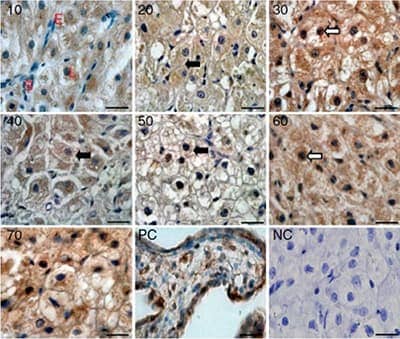Control Tissue Slides for Immunohistochemistry (IHC)
Tissue Slides by Human Organ System | Related Links
We offer easy access to over 400 formalin-fixed paraffin-embedded (FFPE) and over 200 frozen tissue sections of healthy and diseased organs, including brain, lung, liver, and kidney. Our control slides contain a single tissue section mounted on a glass slide. These slides are ideal for rapid identification of protein expression and distribution by immunohistochemistry (IHC) or RNA cellular localization by in situ hybridization (ISH). In addition, they can serve as a positive or negative tissue control, in which the tissue is known to either express or lack expression of the target antigen.

Detecting canine HIF1A expression in the corpus luteum 10-70 days after ovulation using polyclonal HIF1A antibody, [NB100-134]. The experiment includes a positive control, PC (placental tissue), and a negative control, NC. Image from a verified customer review.
What are the Benefits of using Prepared Tissue Slides?
- Serve as experimental controls: Can function as positive and negative tissue controls to provide confidence in your IHC experiment.
- Test normal and disease state differential expression: Normal and disease state tissue sections available to determine differential expression of your target.
- Access to a large number of scarce tissue sections: Over 400 formalin-fixed paraffin-embedded sections and over 200 frozen tissues from various normal and diseased tissue.
Circulatory System (Cardiovascular and Lymphatic System)
The circulatory system, which includes the cardiovascular and lymphatic systems, transports fluid (blood and lymph, respectively) throughout the body within a network of vessels. In the cardiovascular system, the heart pumps oxygenated blood and nutrients to the body via the arteries, originating with the aorta, and deoxygenated blood is transferred back to the heart by the veins. Since lymph nodes are loaded with immune cells such as macrophages, dendritic cells, T cells, and B cells, the lymphatic system is a key component of the immune system and is involved in clearing foreign particles, dead and cancerous cells.
| Arterial Tissue | Spleen Tissue |
| Bone Marrow Tissue | Tonsil Tissue |
| Cardiac Tissue | Venous Tissue |
| Lymphatic Tissue |
Digestive System
Starting with the mouth and ending with the anus, the digestive system consists of hollow organs that form the gastrointestinal (GI) tract, and solid organs including the liver, pancreas, and gallbladder. The digestive system is primarily responsible for food intake, digestion, nutrient absorption into the bloodstream, and waste removal.
Endocrine System
The endocrine system is made up of a network of glands that release hormones into the bloodstream to act on distant cells in order to control homeostasis, metabolism, growth and development, and reproduction. The endocrine system includes:
Integumentary and Musculoskeletal Systems
The integumentary and musculoskeletal systems include the skin, soft tissue, skeletal muscle, cartilage, and bone. These systems function as a barrier from extrinsic factors, regulate body temperature, store nutrients, and provide body movement and support.
| Adipose Tissue | Pelvic Tissue |
| Bone Tissue (Osseous Tissue) | Skeletal Muscle Tissue |
| Maxillary Tissue | Skin Tissue |
| Nipple Tissue | Soft Tissue |
Multiple Organs and Tissues
Nervous System
The nervous system is divided into the central nervous system (CNS), consisting of the brain and spinal cord, and the peripheral nervous system (PNS), which includes all nerves outside of the CNS. The main parts of the brain are the cerebrum (front), brainstem (middle), and cerebellum (back) in addition to the pons, medulla, spinal cord, frontal lobe, parietal lobe, occipital lobe and temporal lobe. By transmitting signals between the brain and the rest of the body, the nervous system controls movement, respiration, vision, cognition, and many other activities.
Reproductive System
The reproductive system involves the organs required for producing offspring. The female reproductive organs include the vagina, ovaries, fallopian tubes, cervix, and the uterus, which has a muscular outer layer called the myometrium and an inner lining called the endometrium. Often overlapping with the urinary system, the male reproductive organs include the prostate, testicles, penis, and the vas deferens (or ductus deferens) which is responsible for transporting semen from the epididymis to the urethra.
Respiratory System
The respiratory system is responsible for the breathing process, notably the uptake of oxygen and release of carbon dioxide. The lower respiratory tract, which is directly involved in gas exchange, consists of the lungs, bronchi, bronchioles, and air sacs (alveoli). The nose, nasal cavity, sinuses, larynx, and trachea make up the upper respiratory tract, providing a passageway and conditioning respiratory gas for the lungs (e.g. filtering, humidifying, and warming air).
Sensory System
The eye is the key sensory organ of the visual system and is composed of three layers: the sclera, the choroid, and the retina. After light passes through the pupil, the lens focuses the electromagnetic rays onto the retina, which in turn transmits a nerve impulse to the brain for interpretation.
Urinary System
The urinary system is responsible for filtering blood and for producing the waste product, urine, which is expelled from the body. The organs that make up the urinary system are the kidneys, renal pelvis, ureters, bladder, and urethra.